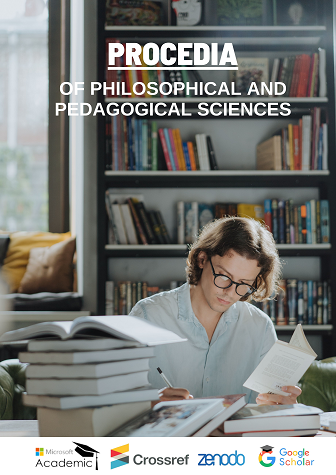History of Musical Science in the Interpretation of Kaykovus’ Work “Kobusnoma”
Keywords:
Cultural Heritage, National Value, Music, Singing Art, Traditions of Excellence, “Shokhnoma”, “Kobusnoma”, Musician, Singer, Musical Taste, AestheticsAbstract
The interpretation of Kaykovus' work "Kobusnoma" and the opinions expressed in it are highlighted from the point of view of a holistic connection with the composer, performer and text. The section “About Hafiz and Musicians” talks about connoisseurs of musical science. It is recognized that a person who considers all art to be his destiny must be able to play a musical instrument. It is emphasized that music is considered an important factor in the formation of the inner world of children, the development of aesthetic taste and level, and proposals are formed on their basis.
References
J. Rubel, “‘You never need an analyst with Bobby around’: The mid-20th-century human sciences in Sondheim and Furth’s musical Company,” Hist Human Sci, vol. 35, no. 3, pp. 168–192, 2022, doi: 10.1177/09526951211049922.
K. M. Kurlenya, “The Search for Meaning in Music: Scientific Breakthroughs and Deadlocks. Analytical Review of Selected Achievements of Musical Cognitive Science,” Nauchnyy Vestnik Moskovskoy Konservatorii, vol. 12, no. 2, pp. 136–163, 2021, doi: 10.26176/mosconsv.2021.45.2.007.
F. Debruyne, “Tracing the music actor-network: Losing the meaning of musical experience? The limits of a routinization of science and technology studies applied to techniques and knowledges of music,” Rethinking Music through Science and Technology Studies, pp. 256–267, 2021, doi: 10.4324/9780429268830-18.
H. M. Zhou, “Retraction Note: Musical poetics in instrumental music: China’s intangible cultural heritage in the information age (Heritage Science, (2022), 10, 1, (87), 10.1186/s40494-022-00726-1),” Herit Sci, vol. 12, no. 1, 2024, doi: 10.1186/s40494-024-01450-8.
S. Isola, “On the relationships between ancient exact science and musical acoustics,” Rendiconti Lincei, vol. 32, no. 4, pp. 817–839, 2021, doi: 10.1007/s12210-021-01026-9.
M. Bick, “International workshop: Women in the Czech musical culture in the 19th century. Prague, October 23-24, 2020, organized by the Institute of Art History of the Czech Academy of Sciences (Ústav dejin umení Akademie ved CR), in cooperation with the Sophie Drinker Institute of Bremen, online conference,” Hudebni Veda, vol. 58, no. 2, pp. 275–279, 2021, [Online]. Available: https://www.scopus.com/inward/record.uri?partnerID=HzOxMe3b&scp=85115378210&origin=inward
A. D. Rahmat, “Improve critical thinking skills using traditional musical instruments in science learning,” International Journal of Evaluation and Research in Education, vol. 12, no. 4, pp. 2165–2175, 2023, doi: 10.11591/ijere.v12i4.25753.
A. R. Coelho, “Historical Music Archival Science applied to Wind Bands archives: a look at the state of the matter,” Boletim do Arquivo da Universidade de Coimbra, vol. 36, no. 1, pp. 59–75, 2023, doi: 10.14195/2182-7974_36_1_2.
“Ghassan Sahhab: The qanun box zither in the Middle East between practice and theory: Developments of a ‘traditional’ musical instrument in the 20th century. PhD thesis in literature and human sciences, ethnomusicology, defended on December 19, 2022,” Cahiers d’Ethnomusicologie, no. 36, 2023, [Online]. Available: https://www.scopus.com/inward/record.uri?partnerID=HzOxMe3b&scp=85200938870&origin=inward
A. G. Korobova, “Genre as a Classification Category in the History of Musical Science,” Nauchnyy Vestnik Moskovskoy Konservatorii, vol. 14, no. 3, pp. 408–419, 2023, doi: 10.26176/mosconsv.2023.54.3.01.
S. Gates, “Developing musical imagery: Contributions from pedagogy and cognitive science,” Music Theory Online, vol. 27, no. 2, 2021, doi: 10.30535/MTO.27.2.3.
S. Walczak, “Detection of Musical Borrowing Using Data Science,” Proceedings of the Association for Information Science and Technology, vol. 60, no. 1, pp. 702–706, 2023, doi: 10.1002/pra2.843.
“Corrigendum to: Autobiographical Significance of Meaningful Musical Experiences: Reflections on Youth and Identity (Music & Science, (2020), 3, (2059204320974221), 10.1177/2059204320974221),” Music Sci (Lond), vol. 6, 2023, doi: 10.1177/20592043231189253.
T. S. Kyuregyan, “About the Principle of Fortspinnung in Musical Science and Practice,” Nauchnyy Vestnik Moskovskoy Konservatorii, vol. 12, no. 3, pp. 72–101, 2021, doi: 10.26176/mosconsv.2021.46.3.003.
H. E. F. Nielsen, “Antarctic Science on the Musical Stage,” Palgrave Studies in Media and Environmental Communication, pp. 143–161, 2024, doi: 10.1007/978-3-031-39787-5_8.
President Shavkat Mirziyoyev's decision "On additional measures to further develop the sphere of culture and art". T., 2022
Umarov M. "The history of pop and public entertainment" Darslik T., "New century generation" 2009
"Nightmare". T., Teacher 1973, p. 95
Niholjonova N "Description of A. Firdavsi's "Shahnoma" epics", Journal of Interdisciplinary Innovations and Scientific Research in Uzbekistan. No. 21, 20.07.2023
Matyakubov E "On the educational possibilities of the musical heritage of Eastern thinkers", Innovative, educational, natural and social sciences Journal. Volume 1, 2021
Downloads
Published
How to Cite
Issue
Section
License

This work is licensed under a Creative Commons Attribution 4.0 International License.
Copyright: © 2024 by the authors. This work is licensed under a Creative Commons Attribution- 4.0 International License (CC - BY 4.0).




